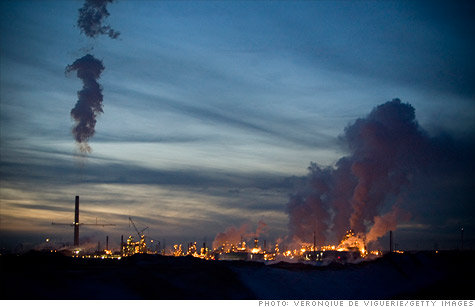Search News

As the United States gets more oil imported from Canada's oil sands, critics worry that the pipelines that carry it will leak.
NEW YORK (CNNMoney) -- U.S. imports of what environmentalists are calling "dirty oil" are set to triple over the next decade, raising concerns over the environmental impact of extracting it and whether pipelines can safely transport this Canadian oil.
The United States currently imports over half a million barrels a day of bitumen from Canada's oil sands region, according to the Sierra Club. By 2020, that number is set to grow to over 1.5 million barrels -- or nearly 10% of the country's current consumption.
The U.S. Energy Information Administration's overall Canadian oil production numbers are in-line with the Sierra Club's projected pace.
Bitumen is a heavy, tar-like oil. It needs to be heavily processed in order to be turned into lighter, easier to refine, crude oil. Because bitumen is so thick, to make it more fluid and easier to move by pipeline, it gets diluted with natural gas liquids.
Besides the sheer amount of energy and water needed to process and extract bitumen, environmentalists say it's more dangerous to move because it's more corrosive to pipelines than regular crude.
While the industry maintains bitumen is safe, the danger of transporting it is one of the reasons there is so much opposition to the Keystone pipeline expansion, which is supposed to carry it, among other oil products.
"We've got all this unconventional crude, and we're completely unprepared for it," said Michael Marx, a senior campaign director at the Sierra Club. "It's definitely more dangerous" than regular oil.
Marx says bitumen is not only more abrasive than traditional crude, it's 15 to 20 times more acidic.
The Sierra Club, along with other environmental groups, recently put out a report showing that pipelines in Alberta, where bitumen is commonly transported, had 16 times the number of leaks than pipelines in the United States, which generally don't carry it.
Plus, when bitumen does leak, environmentalists say it's harder to clean up. Unlike regular oil, they say it's heavier than water, meaning it will sink to the bottom of lakes, rivers or bays.
"We just don't have the technical sophistication to vacuum oil off the bottom of a river," he said.
Bitumen currently comes into this country via a pipeline running from Alberta to Wisconsin and in the original Keystone pipeline that terminates in Illinois.
But Canada is planning on vastly increasing the amount of oil -- and bitumen -- that it gets out of its oil sands region. To get that oil out, more infrastructure needs to be built.
Along with the proposed Keystone expansion, other ideas call for pipelines to Canada's West Coast, to the Atlantic Coast through New England, and an expansion of rail lines. All of these routes would pass through sensitive ecological areas.
Canada's oil industry rejects the "dirty oil" moniker.
They say it is more energy and water intensive than some forms of light crude, but not more so than many of the other heavy oils used in the Untied States from places like Mexico, Venezuela, or even California.
The pipeline industry says transporting bitumen isn't any more dangerous than transporting regular crude.
They point to other studies that show it's not any more abrasive or corrosive to pipelines.
The Alberta-to-U.S. bitumen pipeline leak comparison isn't fair, they say, because Alberta uses a different metric to measure pipeline leaks.
More importantly, the industry says the pipeline companies would not agree to carry this stuff if it really was destroying their systems.
"No pipeline operator would want to spend billions of dollars to transport something their pipeline can't handle," said Andy Black, president of the U.S.-based Association of Oil Pipe Lines.
Plus, he said refineries, which are basically a massive twist of steel pipes, would not want this stuff if it really was more corrosive.
In case of a spill, Black said he hadn't heard of any regulator suggesting bitumen is any more difficult to clean than regular crude.
The industry says that because the bitumen is blended with natural gas liquids, it does not sink in water.
For now, what all sides seem to agree on is the need for more study.
"Right now, there's such an information deficit," said Nathan Lemphers, a policy analyst at Pembina, a Canadian environmental group that supports oil sands development but thinks it needs more regulation.
The U.S. Department of Transportation, which regulates oil pipelines in the United States, said it is studying the transport of bitumen to see if it is any more dangerous, as required by the recently-passed pipeline safety bill.
The industry is hoping the study will prove them right.
"A study that is completed carefully will hopefully put to rest this allegation," said Black. ![]()
| Overnight Avg Rate | Latest | Change | Last Week |
|---|---|---|---|
| 30 yr fixed | 3.80% | 3.88% | |
| 15 yr fixed | 3.20% | 3.23% | |
| 5/1 ARM | 3.84% | 3.88% | |
| 30 yr refi | 3.82% | 3.93% | |
| 15 yr refi | 3.20% | 3.23% |
Today's featured rates:
| Latest Report | Next Update |
|---|---|
| Home prices | Aug 28 |
| Consumer confidence | Aug 28 |
| GDP | Aug 29 |
| Manufacturing (ISM) | Sept 4 |
| Jobs | Sept 7 |
| Inflation (CPI) | Sept 14 |
| Retail sales | Sept 14 |